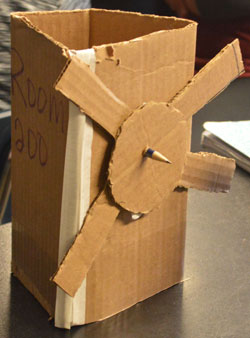Jason Bunker likes the idea of living off the grid: hunting, relying on the land and harnessing wind energy.
“I would like not being on a game 24/7, not being inside, actually living how people used to and not having everything handed to you,” he said. “If something ever does happen – if there’s no power or something – you would know how to live and survive.”
Kalani Stowe agreed, envisioning perhaps bubbling brooks, chirping birds and a turning windmill. “I like listening to the sound of nature.”
But Samantha Gross said an unplugged lifestyle is just not for her. “I would never… I want an actual refrigerator. I like cold water.” Added Reagan Passino, “I want my phone, technology.”

Wyoming Junior High seventh-graders recently worked in groups and presented plans, just in case their parents decide a self-sufficient lifestyle is the way to go.
With a limited budget and resources, they devised windmills, water wheels and generators – methods to keep the lights on without hooking up to an external energy source.
Included in their presentations about the devices and how they work were concepts such as electrical force, hydroelectricity, energy transfer, potential energy and kinetic energy.
Nemi Pinos said using electricity isn’t as simple as flipping a switch. “You have to put a lot of effort into these things,” she said. “You have to organize, think through it, and find out what materials and resources you need to make a windmill work.”
On top of that, one must be careful to not impact animal habitats or neighbors, Nemi said.

A New Approach to Science
The students, in teachers Michelle McSorley, Amy Dunn and Kristi Vugteveen’s science classes, were completing a unit within the MiSTAR curriculum, which is aligned with Next Generation Science Standards, a set of teaching guidelines for kindergarten through 12th-graders outlined in “A Framework for K-12 Science Education.”
NGSS tasks students to redesign, rebuild and tweak projects as many times as it takes, and to explore open-ended questions. Wyoming Junior High started using the MiSTAR curriculum as a pilot program last school year.
The approach challenges students to think deeply, McSorley said. It’s taught sans textbook, relying on Chromebooks, notebooks and experimentation through hands-on projects. Vocabulary is taught by embedding it in discussion, but not as a list of definitions to memorize.
Students are completing projects around thermal energy and the life cycle of building materials, too. They’ve made an electromagnet, and also visited a skateboard park to explore how to get a skater to go higher and faster.
“It’s a different way of thinking. The thing that frustrates most kids is that I don’t answer their questions,” McSorley said. That can be very annoying. They have to figure it out.”
They are learning a few other life skills too, she said, referring to the off-the-grid project with a laugh.
“They are learning why their parents tell them to turn off the lights.”












